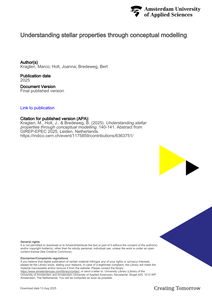We present the Stargazing Live! program comprising a planetarium experience and supporting lesson activities for pre-university physics education. The mobile planetarium aims to inspire and motivate learners using real telescope data during the experience. Learners then consolidate their learning by creating conceptual models in the DynaLearn software. During development of the program, content experts and stakeholders were consulted. Three conceptual model lesson activities have been created: star properties, star states and the fusion-gravity balance. The present paper evaluates the planetarium experience plus the star properties lesson activity in nine grade 11 and 12 classes across three secondary schools in the Netherlands. Learners are very positive about the planetarium experience, but they are less able to link the topics in the planetarium to the curriculum. The conceptual modelling activity improves the learners understanding of the causal relationship between the various stellar properties. Future work includes classroom testing of the star states and fusion-gravity balance lessons.
DOCUMENT
Occupational stress can cause health problems, productivity loss or absenteeism. Resilience interventions that help employees positively adapt to adversity can help prevent the negative consequences of occupational stress. Due to advances in sensor technology and smartphone applications, relatively unobtrusive self-monitoring of resilience-related outcomes is possible. With models that can recognize intra-individual changes in these outcomes and relate them to causal factors within the employee's context, an automated resilience intervention that gives personalized, just-in-time feedback can be developed. This paper presents the conceptual framework and methods behind the WearMe project, which aims to develop such models. A cyclical conceptual framework based on existing theories of stress and resilience is presented as the basis for the WearMe project. The operationalization of the concepts and the daily measurement cycle are described, including the use of wearable sensor technology (e.g., sleep tracking and heart rate variability measurements) and Ecological Momentary Assessment (mobile app). Analyses target the development of within-subject (n=1) and between-subjects models and include repeated measures correlation, multilevel modelling, time series analysis and Bayesian network statistics. Future work will focus on further developing these models and eventually explore the effectiveness of the envisioned personalized resilience system.
DOCUMENT

In this workshop we present three lesson activities to teach core (astro)physics concepts at pre-university level which students find difficult to grasp with traditional interventions: star properties, star states and the fusion-gravity balance. In each activity, students construct and simulate a conceptual cause-effect model. An evaluation study in nine Dutch classrooms showed that the star properties lesson significantly increased students’ understanding of the underlying causal relationships. The lessons were created as part of the Stargazing Live! project, which inspires students with an interactive planetarium lesson incorporating real astrophysical data before triggering deep learning with the conceptual modelling activities.
MULTIFILE
